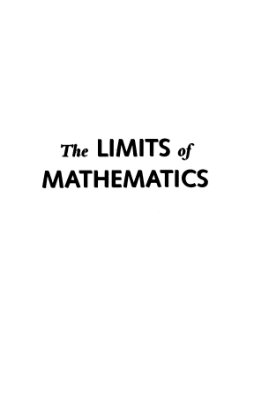Springer, 1997. - 147 pages.
This book is the final version of a course on algorithmic information theory and the epistemology of mathematics and physics. It discusses Einstein and Goedel's views on the nature of mathematics in the light of information theory, and sustains the thesis that mathematics is quasi-empirical. There is a foreword by Cris Calude of the University of Auckland, and supplementary material is available at the author's web site. The special feature of this book is that it presents a new "hands on" didatic approach using LISP and Mathematica software. The reader will be able to derive an understanding of the close relationship between mathematics and physics. "The Limits of Mathematics is a very personal and idiosyncratic account of Greg Chaitin's entire career in developing algorithmic information theory. The combination of the edited transcripts of his three introductory lectures maintains all the energy and content of the oral presentations, while the material on AIT itself gives a full explanation of how to implement Greg's ideas on real computers for those who want to try their hand at furthering the theory. "
This book is the final version of a course on algorithmic information theory and the epistemology of mathematics and physics. It discusses Einstein and Goedel's views on the nature of mathematics in the light of information theory, and sustains the thesis that mathematics is quasi-empirical. There is a foreword by Cris Calude of the University of Auckland, and supplementary material is available at the author's web site. The special feature of this book is that it presents a new "hands on" didatic approach using LISP and Mathematica software. The reader will be able to derive an understanding of the close relationship between mathematics and physics. "The Limits of Mathematics is a very personal and idiosyncratic account of Greg Chaitin's entire career in developing algorithmic information theory. The combination of the edited transcripts of his three introductory lectures maintains all the energy and content of the oral presentations, while the material on AIT itself gives a full explanation of how to implement Greg's ideas on real computers for those who want to try their hand at furthering the theory. "

